Install the app
How to install the app on iOS
Follow along with the video below to see how to install our site as a web app on your home screen.
Note: This feature may not be available in some browsers.
You are using an out of date browser. It may not display this or other websites correctly.
You should upgrade or use an alternative browser.
You should upgrade or use an alternative browser.
Old Apollo Theater manager graded acts from the 40s to 70s on index cards - this is what showBUSINESS looks like!!
- Thread starter geechiedan
- Start date
Shirley Goodman and Leonard Lee
Shirley Goodman (June 19, 1936–July 5, 2005) and Leonard Lee (June 29, 1936–October 23, 1976) were two singers from New Orleans who jointly became known as the “Sweethearts of the Blues.” Born ten days apart, they met when they were children, and both of them sang in their Baptist church. They were discovered by studio owner Cosimo Matassa, who heard Goodman and Lee as part of a school singing group when they were thirteen years old. Matassa got Aladdin Records owner Eddie Messner interested in pairing them as a duo, and New Orleans veteran producer Dave Bartholomew produced their first recording, “I’m Gone,” in 1952, and backed the teenaged singers with many of the most skilled session musicians in New Orleans at the time, including saxophonists Alvin “Red” Tyler, Herb Hardesty and Lee Allen, bassist Frank Fields, and drummer Earl Palmer. “I’m Gone” climbed to No. 2 on the rhythm and blues charts in 1952. This success was followed by a string of other duets, including “Shirley, Come Back to Me,” “Shirley’s Back,” and “The Proposal,” backed with “Two Happy People.” These songs gave Shirley and Lee their stage name, and each new release continued the saga of these presumed teenage sweethearts, which added to the duo’s popularity, though they were never romantically involved; Shirley married contractor Calvin Z. Pixley in 1955. Although both Shirley and Lee sang, theirs was often a call-and-response style rather than a two-part harmony.
Flagging sales prompted Shirley and Lee to change their song topics, starting with “Feels So Good” in 1955. In 1957 they released their most popular song, the anthem “Let the Good Times Roll,” which sold over a million copies. The song was considered too suggestive by many radio stations, and they banned it from their airwaves. Shirley and Lee remained with Aladdin Records until 1959, when they moved to Warwick Records, followed by Imperial Records in 1962. The duo never equaled their biggest hit, and broke up in 1963.
Lee released some singles on his own before he died of a heart attack on October 23, 1976. Shirley moved to Los Angeles, California, and continued singing. She contributed background vocals to Sonny and Cher, as well as the double album Exile on Main Street (1972) by the Rolling Stones and Dr. John’s Gumbo (1972). She quit music for a while in the early 1970s before she reacquainted herself with Sylvia Robinson of the group Mickey and Sylvia, who was also the owner of the All Platinum label. Robinson recorded Shirley on the pre-disco hit “Shame, Shame, Shame” as Shirley and Company on Vibration Records in 1974. This track made it to No. 1 on the rhythm and blues charts and No. 12 on the Billboard pop charts. Her next single, “Cry Cry Cry,” did not sell nearly as well, and Shirley stopped singing professionally. She moved back to New Orleans, where she successfully sued to get her back royalties for “Let the Good Times Roll.” After suffering a stroke, Shirley moved to Los Angeles in 1994. She died there on July 5, 2005, and was buried at Mount Olivet Cemetery in New Orleans.

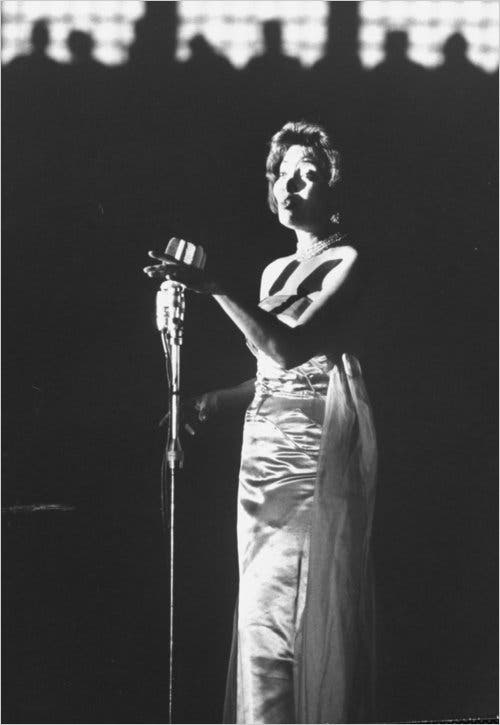
Joya Sherrill (August 20, 1924 – June 28, 2010) was an American jazz vocalist and children's television show host.
Sherrill was born in Bayonne, New Jersey on August 20, 1924.[1] Her first ambition was to become a writer:[1] she was the editor of her school paper.[2] She had a sister, Alice.[1]
Sherrill began her career with Duke Ellington in 1942 when she was seventeen.[1] Ellington considered her one of his favorite singers.[3] After the 1940s, Sherrill performed with Ray Nance and Rex Stewart, both former sideman for Ellington.[3] She married Richard Guilmenot in the mid-1940s.[1] She worked with Ellington again on the television broadcast A Drum Is a Woman (1957), and toured the USSR with Benny Goodman in 1962.[1]
From 1970 Sherrill had a children's television show, Time for Joya, later called Joya's Fun School.[1] This was recorded for a few years, but was rerun until 1982.[1] In the mid-1970s she accompanied her husband when he went to Iran for his work.[2] There, she had her own television program, which was broadcast live.[2] She returned to singing in New York near the end of that decade.[2] Her husband died in 1989;[1] they had a son and a daughter.[2] Sherrill died from leukemia at home in Great Neck, New York on June 28, 2010.[3]

Wow! That show used to come on channel 11 when I was a kid.
Thought I was the only one with scouting reports...
2017
@Hotlantan ,mother:
2019
@lightbright , mother
2017
@Hotlantan ,mother:
- $2 pussy value
- $20 head (monster dome)
- Fat AF however and smells like piss
2019
@lightbright , mother
- $5 max value on pussy
- $3 head (too much teef and talk)
- Too much like a toilet (short, white, and stink like shit)
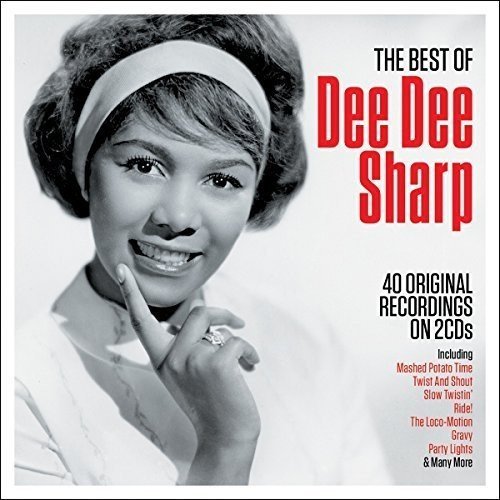
Dee Dee Sharp hit the biggest with her first record for the Cameo/Parkway label, a blessing that pigeonholed the Philly songstress as a teenybopper forever to be identified with her number one smash from 1962, "Mashed Potatoes Time." Living in Philadelphia, the home of Dick Clark's American Bandstand helped her career; she appeared on the syndicated teen dance show many times from 1962 to 1981. The first black female teen idol, Sharp also became a fixture on Clark's Caravan of Stars tours, and a familiar face in the popular 16 Magazine.

Kenny Gamble was responsible for her career stalling. He wanted her at home. Consider all the songs he and Huff were writing for their other female talent. MFSB wasn't full-blown yet but they still had BHY.
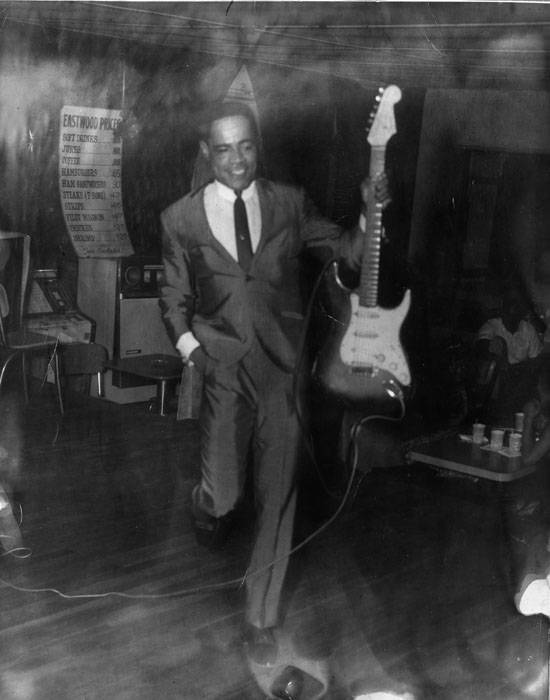
Curly Mays
b. 26 November 1938, Maxie, Louisiana, USA. A nephew of Gatemouth Brown and a cousin of Phillip Walker, Mays was raised in Beaumont, Texas, where he taught himself to play guitar when he was in his early teens. He worked on the streets and in the clubs around Beaumont until his break came in 1959 when he began a three-year stint with the Etta James Revue. Over the years, he also worked with the Five Royales, James Brown and Tina Turner. After a period spent working in hotel bands in Las Vegas, Mays formed his own band in the mid-60s and returned to Texas, where he appeared regularly in clubs from San Antonio to Houston. Veteran Texas bluesman Zuzu Bollin remembered him as a consummate showman blessed with the ability to play the guitar with his bare feet!

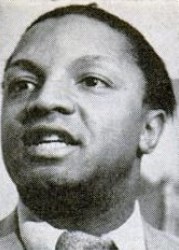
Manhattan Paul
Somewhat of a mystery man in the annals of rock ‘n’ roll. A singer from New York who worked the New Jersey club scene for two decades starting in 1939. He’s described as a large man with a pompadour, always elegantly dressed and openly gay, who specialized in sentimental ballads sung with a clear tone in a higher voice, recording a few songs with Ace Harris along the way that showed him in his element. When rock ‘n’ roll came into existence in the late 1940’s he cut some sides that delved into that realm on Atlantic, roughening his voice some to be more convincing.
None of his records became hits however and he continued to make his living ensconced in the Jersey nightlife, producing shows as well as performing. In 1952 he put on Manhattan Paul’s Revue at the Newark Opera House which included budding female rock star Edna McGriff among its participants.
Though a minor entry in the rock ledger himself his colorful name was adapted by Paul Bascomb sometime after the two recorded sides together for Manor Records in 1948. Manhattan Paul did in fact sing on most of the cuts they did together but on “Rock & Roll” he sat out entirely and Bascomb’s band took center stage with someone in his ranks handling lead vocals. Manor didn’t change the label credit for that side however leading many to believe that it was the same singer as on the flip, “Two Ton Tessie” (which WAS Manhattan Paul).
Though “Rock & Roll” never reached the charts it did stir some interest and down the line, Bascomb, either because it had been assumed he was the “Paul” referenced on the label, or simply because he thought the name was a good drawing card, adopted that moniker for himself in the early 1950’s when cutting further rock records. Because of that original record’s historical importance due to its romping style and the use of the term early in rock’s development, the discographies of the two men have frequently been combined or confused.
Manhattan Paul the club singer saw his recording opportunities dry up before long but he remained a fixture locally for a number of years after his brief moments in the spotlight on national releases in the 1940’s while his name’s lingering historical interest is due mostly to someone else entirely.
MANHATTAN PAUL DISCOGRAPHY (Records Reviewed To Date On Spontaneous Lunacy):
****ROCK AND ROLL
(Manor 1137; September, 1948)
Credited to Manhattan Paul but he did not perform on the record.
HARD RIDIN’ MAMA
(Atlantic 868; December, 1948)
Cover of Wynonie Harris’s 11 month old record certainly improves on most facets of the presentation, but due to the rapidly evolving standards used to judge rock music it is no more or less effective for ITS time than Harris’s was for that earlier time.

This is Paul Basomb's bio since they both recorded on the same label and Bascomb used the "Manhattan" moniker himself....
****ROCK AND ROLL
(Manor 1137; September, 1948)
Credited to Manhattan Paul but he did not perform on the record.
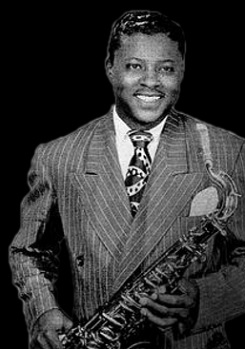
"Manhattan"Paul Bascomb
An unlikely, but enthusiastic, convert to rock ‘n’ roll after a successful career as a sideman in jazz, Bascomb never had a legitimate hit as a rocker but delivered some memorable sides that remain highly regarded well into the 21st century.
Paul Bascomb was born in 1912 in Alabama and in college, at Alabama State, he along with two others founded the Bama State Collegians, a jazz orchestra that somewhat surprisingly became a legitimate national band upon the members graduating and heading to New York in 193 where they hooked up with Erskine Hawkins who became their leader and recorded with them, including such legendary songs as “Tuxedo Junction”.
By now Paul’s younger brother, Dud, a trumpeter, was part of the group and they’d remain with Hawkins until 1944 when the two went out on their own, recording sides for a few years in a more big band style typical for the time.
In 1947 they split their professional relationship and Paul backed up a club singer from New Jersey going by the name of Manhattan Paul on a cut Two Ton Tessie. For the flip side that however, Manor Records let Bascomb’s band cut “Rock And Roll” on their own, yet kept the credits the same, either figuring no one would know or no one would care that the two Paul’s were not the same. Though not a hit it did generate excitement and led Bascomb into pursuing rock music intermittently after that.
By the early 1950’s he had adapted the Manhattan Paul designation for himself, perhaps because listeners had assumed it had referred to him on “Rock And Roll”. The other Manhattan Paul – who has his own entries here – faded from the recording scene before long leaving Bascomb to often get credit for both of their work.
He usually didn’t take vocals, leaving that to his band members, though he did sing on Pink Cadillac and others. While some of his rock releases sold well none became hits and eventually, he returned to jazz where he continued to be highly respected, remaining an enthusiastic performer into the 1980’s.
Bascomb was inducted into the Alabama Jazz Hall Of Fame in 1974 and passed away in at the age of 74 in 1986, one of a handful of artists to make important contributions in both jazz and rock.
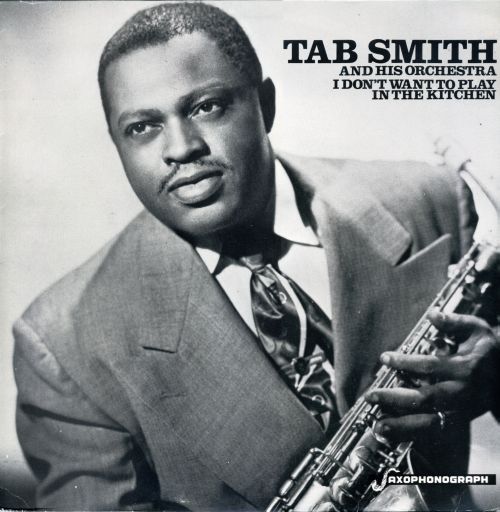
Talmadge "Tab" Smith (January 11, 1909 – August 17, 1971),[1] was an American swing and rhythm and blues alto saxophonist. He is best known for the tracks, "Because of You" and "Pretend". He variously worked with Count Basie, the Mills Rhythm Boys and Lucky Millinder.[1]
Smith was born in Kinston, North Carolina, United States.[1] He joined his first professional band, the Carolina Stompers, in 1929. In the 1930s and 1940s he spent several years in the bands of Lucky Millinder and Count Basie,[2] as well as spending long periods freelancing both as a player and as an arranger. In 1944 he participated in a recording date led by Coleman Hawkins, for which he also arranged the material.[3] After the Second World War he led his own groups, which concentrated on rhythm and blues as jazz turned from swing to bop.
His biggest R&B hit was "Because of You", which reached number 1 on the US Billboard R&B chart, and number 20 on the pop chart, in 1951. "Because of You" was made for United Records, a label for which Smith recorded prolifically until it closed in 1957.[4] Tab Smith put out 24 singles and a 10-inch album for the label. On his United sides, Smith sometimes played tenor saxophone.
During the 1950s, Smith was a significant rival to alto saxophone-playing bandleader Earl Bostic, who recorded for King. He was also in competition with his own formative influence, Johnny Hodges, until Hodges returned to the Duke Ellington band.
His career never recovered from the closure of United Records. After brief stays at Checker and King, Smith retired from the music business in the early 1960s. He sold real estate and played piano part-time in a steakhouse.
He died in St. Louis, Missouri, in August 1971, aged 62.[1]
On June 25, 2019, The New York Times Magazine listed Tab Smith among hundreds of artists whose material was reportedly destroyed in the 2008 Universal fire.[5]

Thought I was the only one with scouting reports...
2017
@Hotlantan ,mother:
- $2 pussy value
- $20 head (monster dome)
- Fat AF however and smells like piss
2019
@lightbright , mother
- $5 max value on pussy
- $3 head (too much teef and talk)
- Too much like a toilet (short, white, and stink like shit)
 why is a faggot thinking about me.... at 3:30 am????? Things that make you say fag
why is a faggot thinking about me.... at 3:30 am????? Things that make you say fag@Soul On Ice mother
- GOLD STAR RATING for her ability to have a dick in each hole, a prostitute "trifecta"
- SUPERHEAD: No teeth, all gums, doesn't dodge the load but blows bubbles with it
- ZOD RATING: 5 STARS
- Two showers required after fucking, with a doctors appointment after to check for crabs and STD's
.
Thought I was the only one with scouting reports...
2017
@Hotlantan ,mother:
- $2 pussy value
- $20 head (monster dome)
- Fat AF however and smells like piss
2019
@lightbright , mother
- $5 max value on pussy
- $3 head (too much teef and talk)
- Too much like a toilet (short, white, and stink like shit)
COME PEOPLE DON'T DERAIL THE THREAD WITH THIS CHILDISH BULLSHIT...IF YOU WANNA GO AT IT THEN START A NEW FUCKIN THREAD.why is a faggot thinking about me.... at 3:30 am????? Things that make you say fag
@Soul On Ice mother
- GOLD STAR RATING for her ability to have a dick in each hole, a prostitute "trifecta"
- SUPERHEAD: No teeth, all gums, doesn't dodge the load but blows bubbles with it
- ZOD RATING: 5 STARS
- Two showers required after fucking, with a doctors appointment after to check for crabs and STD's
.





COULD A MOD PLEASE DELETE THESE STUPID POSTS...
Amazing how you didn't feel the need to address it when it was started by @Soul On Ice ..... truly amazingCOME PEOPLE DON'T DERAIL THE THREAD WITH THIS CHILDISH BULLSHIT...IF YOU WANNA GO AT IT THEN START A NEW FUCKIN THREAD.



COULD A MOD PLEASE DELETE THESE STUPID POSTS...
.
Leslie Marian Uggams (born May 25, 1943)[1] is an American actress and singer. Beginning her career as a child in the early 1950s, Uggams is recognized for portraying Kizzy Reynolds in the television miniseries Roots (1977), earning Golden Globe and Emmy Award nominations for her performance. She had earlier been highly acclaimed for the Broadway musical Hallelujah, Baby!, winning a Theatre World Award in 1967 and the Tony Award for Best Actress in a Musical in 1968. Later in her career, Uggams received renewed notice with appearances alongside Ryan Reynolds in Deadpool (2016) and in a recurring role on Empire.
Uggams started in show business as a child in 1951, playing the niece of Ethel Waters on Beulah. That same year she appeared as a featured performer at the famed Apollo Theater in Harlem, alongside Ella Fitzgerald. She made her professional debut at six on Jack Barry's NBC show "Stars And Stardust." Following that, she performed on "Arthur Godfrey's Talent Scouts," Paul Whiteman's "TV Teen Show. Uggams got her biggest break on The Lawrence Welk Show and was a regular on Sing Along with Mitch, starring record producer-conductor Mitch Miller.[4] In 1954, ten-year-old Uggams made a record for MGM, which included a reworking of the song Santa Baby as "Uncle Santa," with words suitable for a child. In 1960, she sang, off-screen, "Give Me That Old Time Religion" in the film Inherit the Wind. Uggams came to be recognized by TV audiences as an upcoming teen talent in 1958 on the musical quiz show series Name That Tune. A record executive was in the studio audience and signed her to a contract.[6] Her records "One More Sunrise" (an English-language cover of Ivo Robic's "Morgen", 1959) and "House Built on Sand" made Billboard magazine's charts.

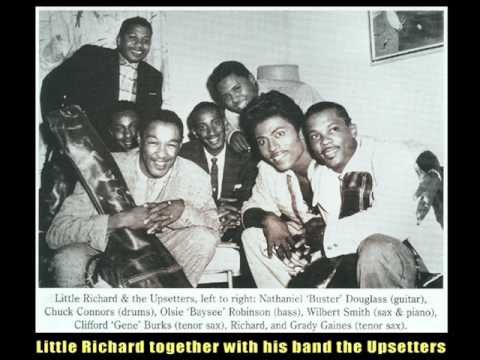
The Upsetters were a band that played with Little Richard from 1953 to the early 1960s.[1] They would continue to tour and record through the late 1960s as a backing band with Otis Redding and as a solo group as well. They have been credited by James Brown and others with first putting the 'funk' in the rock and roll beat.
In 1953, Little Richard, dissatisfied with his solo career, formed a road band starting with Wilburt "Lee Diamond" Smith on saxophone, who became the leader, Nathaniel "Buster" Douglas on Electric guitar, Charles "Chuck" Connor on drums, and Olsie "Bassy" Robinson on bass guitar. Little Richard and the band did many club performances from 1953 to 1955. Little Richard didn't record his first hit "Tutti Frutti" with the Upsetters, but he recorded it with studio musicians who had worked with Fats Domino, after he told Art Rupe, founder of Specialty Records, that he liked Fats Domino's music. He recorded a number of songs with the Upsetters such as "Keep A Knockin'", and "Ooh My Soul" however most of his big hits in his prime were recorded with a studio band which included Lee Allen and Earl Palmer

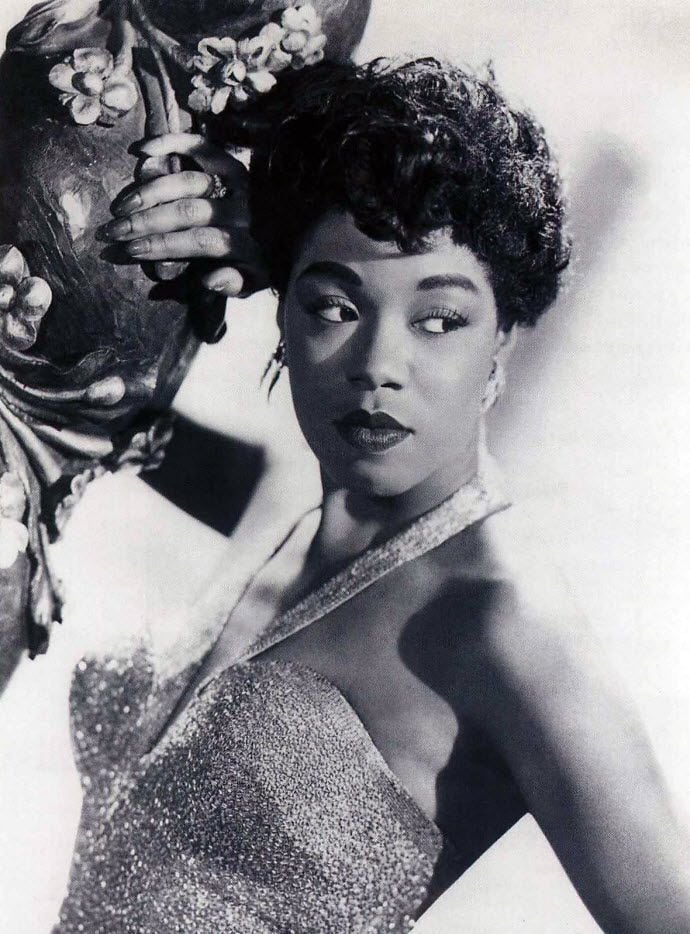
Sarah Lois Vaughan was an American jazz singer. Nicknamed "Sassy" and "The Divine One", she won four Grammy Awards, including the Lifetime Achievement Award. She was given an NEA Jazz Masters Award in 1989. Critic Scott Yanow wrote that she had "one of the most wondrous voices of the 20th century"

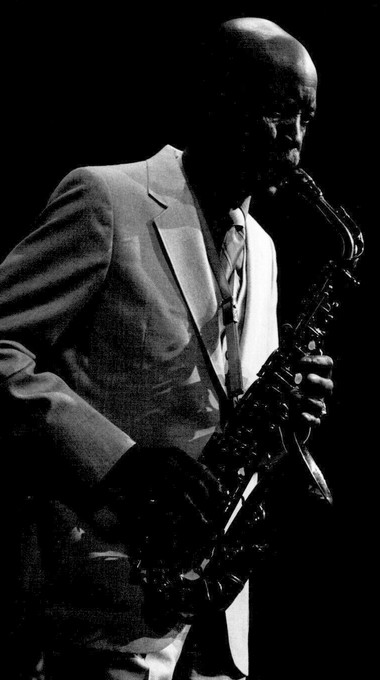
Eddie "Cleanhead" Vinson (born Edward L. Vinson Jr., December 18, 1917 – July 2, 1988) was an American jump blues, jazz, bebop and R&B alto saxophonist and blues shouter.[1] He was nicknamed Cleanhead after an incident in which his hair was accidentally destroyed by lye contained in a hair straightening product.[2] Music critic Robert Christgau has called Vinson "one of the cleanest—and nastiest—blues voices you'll ever hear."[3]
Vinson was born in Houston, Texas, United States.[4] He was a member of the horn section in Milton Larkin's orchestra, which he joined in the late 1930s.[4] At various times, he sat next to Arnett Cobb, Illinois Jacquet, and Tom Archia, while other members of the band included Cedric Haywood and Wild Bill Davis. After exiting Larkin's employment in 1941, Vinson picked up a few vocal tricks while on tour with bluesman Big Bill Broonzy.[4] He then moved to New York and joined the Cootie Williams Orchestra from 1942 to 1945, recording such tunes as "Cherry Red". Vinson struck out on his own in 1945, forming his own large band, signing with Mercury Records, and enjoying a double-sided hit in 1947 with his R&B chart-topper "Old Maid Boogie", and the song that would prove to be his signature number, "Kidney Stew Blues".[5]
Vinson's jazz leanings were probably heightened during 1952-1953, when his band included a young John Coltrane. In the late 1960s, touring in a strict jazz capacity with Jay McShann, Vinson's career took an upswing. In the early 1960s Vinson moved to Los Angeles and began working with the Johnny Otis Revue. A 1970 appearance at the Monterey Jazz Festival with Otis spurred a bit of a comeback for Vinson. Throughout the 1970s he worked high-profile blues and jazz sessions for Count Basie, Otis, Roomful of Blues, Arnett Cobb, and Buddy Tate. He also composed steadily, including "Tune Up" and "Four", both of which have been incorrectly attributed to Miles Davis.[6]
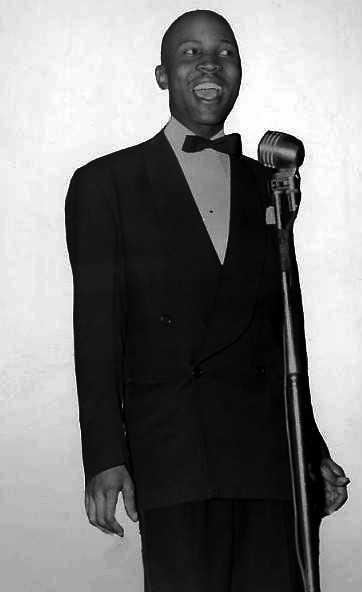
Vinson as the leader of his own band, circa mid-1940s - mid-1950s.


The Vocaleers were an American doo-wop group formed in Harlem, New York, in 1952. Managed by record producer Bobby Robinson, the group released a string of regional hits and scored one national R&B hit with the song "Is It a Dream" in 1953. Highlighted by the distinctive vocal delivery of Joe Duncan, "Is It a Dream" became a standard component of several R&B acts in Harlem and, briefly, the Vocaleers were among the most popular attractions of the city's music scene.
In 1952, the first version of the Vocaleers, featuring Joe Duncan (lead vocals), Herman Dunham (first tenor), William Walker (second tenor), Melvin Walton (baritone) and Teddy Williams (bass), came together after some of the members met each other while playing in a local Davega Stores-sponsored softball league. Originally known as the Rainbows, the group was managed by Jimmy Manning, a former gospel singer who performed with Brook Benton and Howard Lymon Sr. in the Harlemaires. The Rainbows' live appearances were initially limited to school assemblies, but they began receiving exposure at contests arranged at the Apollo Theater with Duncan's song "My Love". Late in 1952, in a record store on 116th Street, the Rainbows demoed another Duncan original, "Be True", with the manager accompanying them on ukelele. Impressed by the song, the manager delivered the demo to Bobby Robinson, who signed the Rainbows to a recording contract on Red Robin Records.[1][2]
In December 1952, the group, then known as the Vocaleers, recorded and released "Be True", paired with "Oh Where", for their debut single. It became a regional hit in cities such as New York City, Philadelphia, and Los Angeles, characterized by Duncan's unusual vocal delivery, which he explained in an interview: "I sing through my nose; I don't do it from the diaphragm.... I have a yo-yo funny voice".[1] For a brief while, the group was the most popular act in Harlem; music writer Nelson George compared the Vocaleers' popularity in the district to sport figures Jackie Robinson and Willie Mays.[3] As the single continued to sell well, the Vocaleers gigged at Lloyd's Manor in Newark, but were forced to replace Williams, who suffered from a case of stage fright followed by tuberculosis, with neighborhood friend Lamar Cooper.[1][2]
Awarding them with a new, lucrative five-year contract, Robinson assembled the Vocaleers back into the studio in March 1953 to record six additional songs. Among the set, "Is It a Dream" and "Hurry Home" were distributed as the Vocaleers follow-up single, which rose to number four on the Billboard R&B charts in June. Soon, local doo wop groups incorporated "Is It a Dream" into their own repertoire, making it a standard of the doo wop music genre, and, with its good fortune, the Vocaleers were packaged in tours alongside other acts.[4] Some of the groups/musicians the Vocaleers performed with include Dinah Washington, the Five Royales, Pigmeat Markham, and Arnett Cobb.[1]
Robinson called the group back to the studio to record "I Walk Alone" and "How Soon", much to the reluctance of Duncan, who feared the new record would take sales away from "Is It a Dream". When "I Walk Alone" was not too commercially successful, the group recorded their fourth single "Will You Be True" in December 1953, before Dunham announced he was leaving the Vocaleers, possibly over disputes with lead vocal duties. Replaced by Joe Powell, Dunham, adopting the stage name Herman Curtis, joined the Solitaires soon after. However, the Vocaleers did not survive long after Dunham's departure, with Walker and Walton leaving to form the Savoys in July 1954 and Duncan joining the military. Robinson, who still retained rights to the act's name, recorded one song, "If Your Heart Aches", with unknown session musicians.[1][4]
When Duncan returned from the service in late 1958, he reformed the Vocaleers with most of the original line-up. They recorded tunes for Old Town Records and Vest Records in 1959 and 1960 before disbanding for the last time in 1962. In recognition of their contributions to R&B music, the Vocaleers were inducted into the UGHA Hall of Fame in April 1996.

and i would like to read every last one of them....
Eddie Wilcox

Eddie Wilcox (December 27, 1907 – September 29, 1968) was an American jazz pianist and arranger.
Born in Method, North Carolina, Wilcox studied at Fisk University, where he met Jimmie Lunceford. He played with Lunceford in college bands and then professionally in the mid-1920s. In 1929 he became the main arranger for Lunceford's ensemble, and remained so until Lunceford's death in 1947.[1] He was named co-leader with Joe Thomas after Lunceford died, and became sole leader in January 1949, where he remained until the group disbanded early in the 1950s. His 1952 cover version recording of "Wheel of Fortune" became a hit in the U.S., peaking at #14.[2] Following this Wilcox played solo at the Cafe Riviera in New York City for nearly a decade.[1]
He along with Jazz tenor saxophonest Teddy McRae founded the Raecox record label in the 1950s, issuing R&B music.[1] He also worked as an executive for Riviera Records and Derby Records. Shortly before his death he worked with Russell Moore.
Jimmie Lunceford's band differed from other great bands of the time because it was better known for its ensemble than for its solo work. Additionally, he was known for using a two-beat rhythm, called the Lunceford two-beat, as opposed to the standard four-beat rhythm.[9] This distinctive "Lunceford style" was largely the result of the imaginative arrangements by trumpeter Sy Oliver, which set high standards for dance-band arrangers of the time.[5] Though not well-known as a musician, Lunceford knew how to play several instruments and was even featured on flute in "Liza".[10]
Comedy and vaudeville played a distinct part in Lunceford's presentation. Songs such as "Rhythm Is Our Business" (featured in a 1937 musical short with Myra Johnson (Taylor) on vocals), "I'm Nuts about Screwy Music", "I Want the Waiter (With the Water)", and "Four or Five Times" displayed a playful sense of swing, often through clever arrangements by trumpeter Sy Oliver and bizarre lyrics. Lunceford's stage shows often included costumes, skits, and obvious jabs at mainstream white bands, such as Paul Whiteman's and Guy Lombardo's.
Despite the band's comic veneer, Lunceford always maintained professionalism in the music befitting a former teacher; this professionalism paid off and during the apex of swing in the 1930s, the Orchestra was considered the equal of Duke Ellington's, Earl Hines' or Count Basie's. This precision can be heard in such pieces as "Wham (Re-Bop-Boom-Bam)", "Lunceford Special", "For Dancers Only", "Uptown Blues", and "Stratosphere". The band's noted saxophone section was led by alto sax player Willie Smith. Lunceford often used a conducting baton to lead his band.
The orchestra began recording for the Decca label and later signed with the Columbia subsidiary Vocalion in 1938. They toured Europe extensively in 1937, but had to cancel a second tour in 1939 because of the outbreak of World War II. Columbia dropped Lunceford in 1940 because of flagging sales. (Oliver departed the group before the scheduled European tour to take a position as an arranger for Tommy Dorsey). Lunceford returned to the Decca label. The orchestra appeared in the 1941 movie Blues in the Night.
Most of Lunceford's sidemen were underpaid and left for better paying bands, leading to the band's decline.[10]

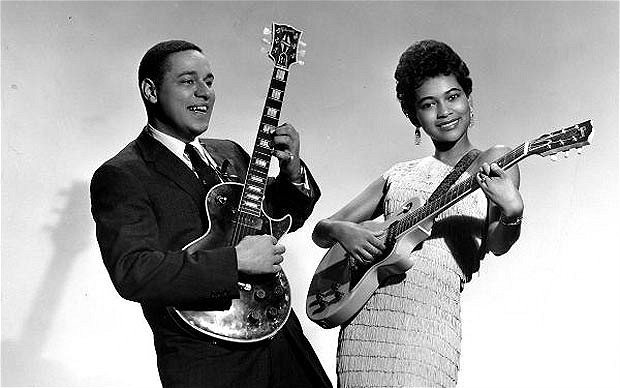
Mickey & Sylvia was an American R&B duo composed of Mickey Baker and Sylvia Vanterpool, who later became Sylvia Robinson. They are best known for their number-one R&B single "Love Is Strange" in 1957. Baker and Vanterpool began recording together in 1954.
YOOOOOO!!!!!!!! THIS BROAD SET IT OFF!!!!!
Sylvia Robinson (née Vanderpool; May 29, 1935[3][4][5][7] – September 29, 2011) was an American singer, musician, record producer, and record label executive. Robinson had two R&B chart toppers: as half of Mickey & Sylvia with "Love Is Strange" in 1957 and her solo record "Pillow Talk" in 1973. She later became known for her work as founder and CEO of the hip hop label Sugar Hill Records.[8] Robinson is credited as the driving force behind two landmark singles in the hip hop genre; "Rapper's Delight" (1979) by the Sugarhill Gang,[9] and "The Message" (1982) by Grandmaster Flash and the Furious Five; which caused her to be dubbed "The Mother of Hip–Hop". Robinson received a Pioneer Award for her career in singing and being the founder of Sugarhill Records at the 11th Annual Rhythm and Blues Awards Gala in 2000.[10]
She basically broadcasted the genre of hip hop.I could be wrong but this sound could have been Buddy Holly’s inspiration.
She basically broadcasted the genre of hip hop.
Well, she certainly monetized it.
An understatement but yeah.Well, she certainly monetized it.
Similar threads
- Replies
- 0
- Views
- 81
- Replies
- 25
- Views
- 1K
- Replies
- 67
- Views
- 3K
- Replies
- 4
- Views
- 489



